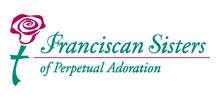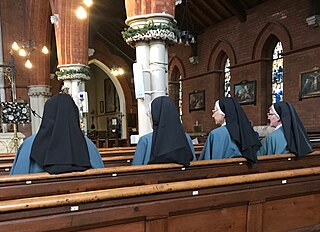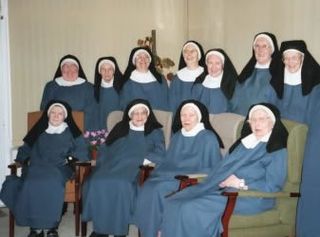
Halloween or Hallowe'en is a celebration observed in many countries on 31 October, the eve of the Western Christian feast of All Hallows' Day. It is at the beginning of the observance of Allhallowtide, the time in the liturgical year dedicated to remembering the dead, including saints (hallows), martyrs, and all the faithful departed. In popular culture, the day has become a celebration of horror, being associated with the macabre and supernatural.

A nun is a woman who vows to dedicate her life to religious service and contemplation, typically living under vows of poverty, chastity, and obedience in the enclosure of a monastery or convent. The term is often used interchangeably with religious sisters who do take simple vows but live an active vocation of prayer and charitable work.

Ditchingham is a village and civil parish in the English county of Norfolk. It is located across the River Waveney from Bungay, Suffolk.

A convent is a community of monks, nuns, friars or religious sisters. Alternatively, convent means the building used by the community. The word is particularly used in the Catholic Church, Lutheran churches, and the Anglican Communion.

La Crosse is a city in the U.S. state of Wisconsin and the county seat of La Crosse County. Positioned alongside the Mississippi River, La Crosse is the largest city on Wisconsin's western border. La Crosse's population as of the 2020 census was 52,680. The city forms the core of and is the principal city in the La Crosse–Onalaska Metropolitan Area, which includes all of La Crosse County and Houston County, Minnesota, with a population of 139,627.

All Hallows College was a college of higher education in Dublin. It was founded in 1842 and was run by the Vincentians from 1892 until 2016. On 23 May 2014, it was announced that it was closing because of declining student enrollment. The sale of the campus in Drumcondra to Dublin City University was announced on 19 June 2015 and completed on 8 April 2016. The college closed on 30 November 2016, becoming the All Hallows Campus of Dublin City University.
Crosse is a surname, and may refer to:

The Franciscan Sisters of Perpetual Adoration (FSPA) is a Roman Catholic religious congregation for women whose motherhouse, St. Rose of Viterbo Convent, is in La Crosse, Wisconsin, in the Diocese of La Crosse. The Franciscan Sisters of Perpetual Adoration founded Viterbo University and staffed Aquinas High School in La Crosse. The congregation traces its roots to 1849.
All Hallows or Allhallows or variation, may refer to:
Lavinia Crosse founded the Community of All Hallows in Ditchingham in 1855. She was the daughter of the famous Norwich surgeon John Green Crosse.
The Sisters of Life is a Catholic religious institute for women, following the Augustinian rule. It is both a contemplative and active religious community, active in the promotion of anti-abortion causes. The abbreviation S.V. stands for Sorores Vitae, Latin for "Sisters of Life."

The Community of St John Baptist (CSJB), also known as the Sisters of Mercy, or formerly Clewer Sisters, is an Anglican religious order of Augustinian nuns.

The Community of the Sisters of the Church is a religious order of women in various Anglican provinces who live the vowed life of poverty, chastity and obedience. In 2012 the order had 105 sisters living in community, together with an extensive network of associates.

All Hallows' School (AHS) is a Catholic day school for girls, located in Fortitude Valley, close to the central business district of Brisbane, Queensland, Australia.

St. Rose of Viterbo Convent is the motherhouse of the Franciscan Sisters of Perpetual Adoration, an American religious congregation, which is located in La Crosse, Wisconsin. The convent is dedicated to Rose of Viterbo, a 13th-century Franciscan tertiary who was a noted mystic and street preacher in Italy who died while still a teenager.

Mother Mary Vincent Whitty, R.S.M., was an Irish religious sister known for her work in the colony of Queensland. She was a leading figure in the Institute of the Sisters of Mercy, both in Ireland and in its expansion into the Australian colonies.
Augustinian nuns are named after Saint Augustine of Hippo and exist in the Roman Catholic and Anglican churches. In the Roman Catholic Church there are both enclosed monastic orders of women living according to a guide to religious life known as the Rule of St Augustine, and also other independent Augustinian congregations living in the spirit of this rule. In the Anglican Communion, there is no single "Order of St Augustine", but a number of Augustinian congregations of sisters living according to the Rule of St Augustine.
Former religious orders in the churches of the Anglican Communion are those communities of monks, nuns, friars, or sisters, having a common life and rule under vows, whose work has ended and whose community has been disbanded. In a very few cases this is due to the termination of the work for which the community was established, but in most cases it is due to amalgamation or the death of the final remaining member of the community.

The Society of the Sisters of Bethany (SSB) is an Anglican religious order. The sisters follow the Rule of St Augustine. The mother house is now the House of Bethany in Southsea.
William Edward Scudamore (1813-1881) was a prominent Church of England priest, historian, liturgist, chaplain, and devotional author. His popular devotional manual Steps to the Altar reached its sixty-seventh edition in 1887, and was used extensively in North America and on the Indian subcontinent in addition to in Great Britain.














